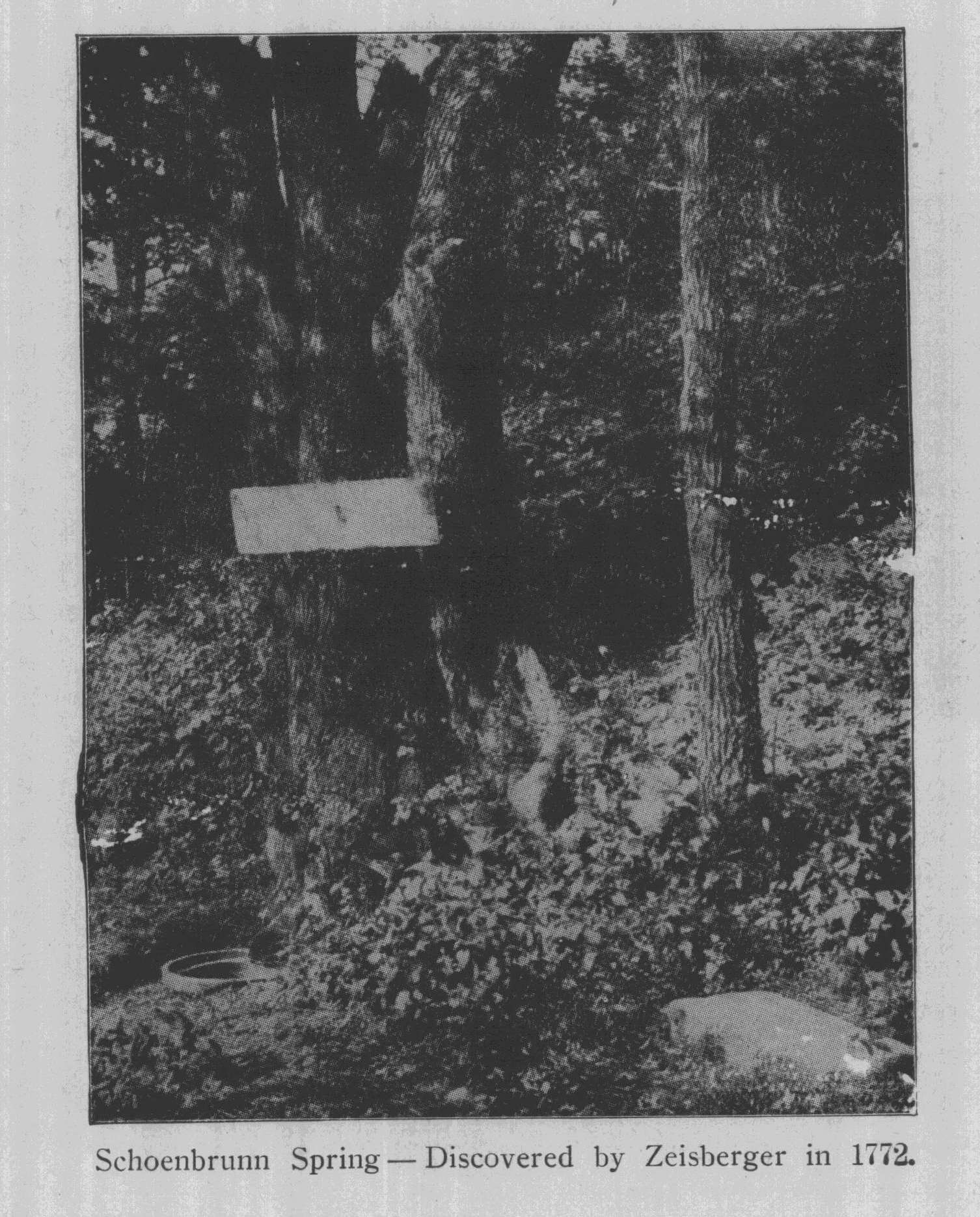Ohio History Journal
David Zeisberger Centennial. 179
Slumber on, and may Christians of
whatever creed
Bow their heads to the altered
condition,
And as years roll along with eternity
speed
Give thy tomb its deserved recognition.
Slumber on in the vale far away from thy
birth
Where pure beauty and plenty fail never,
Where thy victories were in the efforts
put forth
For the Race almost vanquished forever.
SITE OF LICHTENAU.
Regarding the location of Lichtenau,
founded by Rev. David
Zeisberger of the work of Heckewelder
and Zeisberger and the
first spelling book used in Ohio, Rev.
W. H. Rice, D. D., says the
following:
Lichten-Au is a German word, signifying
a Pasture or
Meadow of Light here the name is
significant of God's smile upon
the green pasture lands. It was the name
given by Rev. David
Zeisberger to the Christian village
settlement which he founded
in April, 1776, on the eastern bank of
the Muskingum river, two
and a half miles below Goshochkunk
(Coshocton) in accordance
with the urgent wishes of the chief of
the Delaware Indian Na-
tion. Chief Netawatwes whose capital was
Goshochkunk the
Indian name which has survived in
"Coshocton." Netawatwes
selected the site in such proximity to
his capital because, "If the
brethren will live near me, I will be
strong. They will make me
strong against the disobedient."
The site is a broad level of many acres
stretching to the foot
hills with a slight rise. The river bank
has an arc-shaped out-
line and was covered with maples and
sycamores. There was a
rich soil, and an abundance of materials
for building.
The pre-historic relics tell of its
having been occupied once
before as a village site. There is a
circle of five acres and a
mound. The former is quite near this
site of Lichtenau and the
latter three-quarters of a mile down the
river.
Forty-five years ago the site of
Lichtenau was identified as
stretching across the long lane that
runs from the river to the
foot hills, separating the farms then
owned by Mr. Samuel Moore
and Mr. Samuel Foraker, in Tuscarawas
township, in Coshocton
180 Ohio Arch. and Hist.
Society Publications.
county. The church probably stood in the
yard of Mr. Moore,
and the town stretched across over the
farm of Mr. Foraker.
The settlement of the Lichtenau village
was begun by Rev.
David Zeisberger on April 12, 1776, just one day after his 55th
birthday anniversary. Eight families
accompanied Zeisberger
and his assistant, Rev. John
Heckewelder, a young man of 33.
It was Saturday. On the following day,
April 13, Chief Neta-
watwes with almost the entire population
of Goshochkunk at-
tended the first Sunday services.
Zeisberger preached on the
text Luke XXIV, 46 and 47.
"Thus it is written and thus it
behooved Christ to suffer,
and to rise from the dead the third day;
and that repentance and
remission of sins should be preached in
His name among all na-
tions beginning at Jerusalem."
The one street of this village ran
parallel to the river. The
church was erected on a lot half way
between its northern and
southern ends. The work prospered from
the outset and con-
tinued as this letter of Pastor
Heckewelder shows. Among the
converted were members of Chief
Netawatwes' family, as well
as himself. The first service at which
the Lord's Supper was
celebrated was on Sunday, May 18, 1776.
At this time the Delaware-English
spelling book by David
Zeisberger, printed for the use of
pupils in the Mission schools ot
these Ohio towns in Philadelphia, Pa.,
was completed and came
into use in these parts. It is the first
Ohio spelling book pub-
lished 132 years ago, for schools at
Schoen-Brunn, Gnadenhutten
and Lichtenau. In July, 1776, the first
baptism took place at
Lichtenau. The convert from among the
heathen Indians was
a grandson of chief Netawatwes. He was
named John. To a
friend who advised him how perilous it
would be for him to risk
religion, John made quick answer, and
brave as it was quick.
"If my life is in danger, I will
the more cheerfully witness
of the truth. Do you imagine that a
baptized Indian fears your
sorceries as he did when he was a
heathen, and that he will hesi-
tate to make known what the Saviour has
done for him and for
all men? No! While I live I will not hold my peace, but pro-
claim salvation. This is the command of
God."
|
David Zeisberger Centennial. 181
Among the men who wielded the axe in cutting timber for the building of Lichtenau was the converted Indian Chief and brave warrior, Isaac Glicklican, who was a church elder as emi- nent for his piety as for his prowess. He perished in the Gnad- enhutten massacre in 1782. |
|
|
